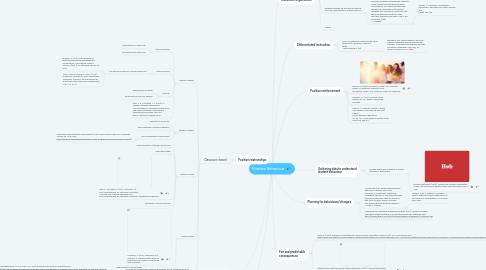
1. Positive relationships
1.1. Classroom-based
1.1.1. Teacher-student
1.1.1.1. Communication
1.1.1.1.1. Expectations of roles clear
1.1.1.1.2. Use positive and calm tone
1.1.1.2. Mutual respect
1.1.1.2.1. Recognize and honour cultural differences
1.1.1.3. Fairness
1.1.1.3.1. Differentiate for needs
1.1.1.3.2. Consequences are fairly applied
1.1.1.4. Brok, P. D., & Tartwijk, J. V. (2015). 21 Teacher–Student interpersonal communication in international education. The SAGE Handbook of Research in International Education, 309-324. doi:10.4135/9781473943506.n21
1.1.2. Student-student
1.1.2.1. Flexibility in groupings
1.1.2.2. Teach language of positive feedback
1.1.2.3. Teach cooperative learning skills
1.1.2.3.1. International Baccalaureate Organization (2018). Project study in the MYP. Retrieved January 26, 2018, from http://www.ibo.org/programmes/middle-years-programme/curriculum/myp-projects/
1.1.3. Teacher-parent
1.1.3.1. Involve parents in learning conferences
1.1.3.2. Share good news
1.1.3.3. Irish, C., & Scrubb, M. (2012, November 12). Five Competencies for Culturally Competent Teaching and Learning. Retrieved from Five Competencies for Culturally Competent Teaching and Learning
1.1.3.4. Recognize cultural diffrences
1.1.4. Communicate
1.1.4.1. Cornelius, S. (2015, September 24). Marzano 13 Teaching Best Practices. Retrieved from Marzano 13 Teaching Best Practices
1.1.5. Government of Manitoba. Manitoba Education. (2011). Towards inclusion: Supporting positive behaviour in Manitoba classrooms. Retrieved from https://www.edu.gov.mb.ca/k12/specedu/behaviour/behaviour_document.pdf
2. Classroom behavioural expectations
2.1. Essential agreements devised by and agreed upon in each class
3. Social skills instruction
3.1. Weekly 50 minute session with class tutor
3.1.1. Approaches to Learning Skills
3.1.1.1. International Baccalaureate Organization. (2014, May). MYP: From principles into practice. Retrieved from https://www.spps.org/site/handlers/filedownload.ashx?moduleinstanceid=38367&dataid=21206&FileName=from_principles_to_practice_2014.pdf
3.1.2. Character strengths development
3.1.2.1. Character Strengths, Character Building Experts | VIA Institute
4. Classroom organization
4.1. Allow/plan for movement
4.2. Provide for active responses
4.3. Minimize distractions
4.4. Consider seating assignments
4.5. Establish routines for entering and exiting the class, and transitions between lessons
4.5.1. “... effective management ... is more an instructional than a disciplinary enterprise. Effective managers socialize their students to the student role through instruction and modeling. It is important that these teachers be consistent in articulating demands and monitoring compliance, but the most important thing is to make sure that students know what to do in the first place.” (185) —J. Brophy
4.5.1.1. Brophy, J. “Classroom Management Techniques.” Education and Urban Society 18.2 (1986): 182-194.
4.6. Manito
5. Differentiated instruction
5.1. “There is nothing so unequal as the equal treatment of students of unequal ability.” —Blanchard et al. (33)
5.1.1. Blanchard, Ken, Patricia Zigarmi, and Drea Zigarmi. Leadership and the One Minute Manager: Increasing Effectiveness Through Situational Leadership. New York, NY: William Morrow and Co., 1985.
6. Positive reinforcement
6.1. Pascha, M. (2019). The PERMA Model: Your Scientific Theory of Happiness. Retrieved from The PERMA Model: Your Scientific Theory of Happiness
6.2. Seligman, M. (2012). Flourish. North Sydney, N.S.W.: William Heinemann Australia.
6.3. Martin E. P. Seligman, Randal M. Ernst, Jane Gillham, Karen Reivich and Mark Linkins Oxford Review of Education Vol. 35, No. 3, Well-being in schools (June 2009), pp. 293-311
7. Fair and predictable consequences
7.1. Case, R. (2005). Bringing critical thinking to the main stage. Education Canada, 45(2), 45-49. Retrieved from http://web.a.ebscohost.com.proxy.queensu.ca/ehost/detail/detail?vid=0&sid=d4830df6-8521-4cbf-8c78-b68da4da1eb3%40sessionmgr4010&bdata=JnNpdGU9ZWhvc3QtbGl2ZQ%3d%3d#AN=507984826&db=eue
7.2. Alberta Provincial Government. Alberta Education. (2007). Fair and predictable consequences. Retrieved from http://www.learnalberta.ca/content/inspb2/html/7_fairandpredictableconsequences.html
8. Gathering data to understand student behaviour
8.1. Monthly grade-level meetings to review progress of approaches
8.1.1. Welsh Government. (2013). Professional learning communities. Crown. Retrieved from Learning Wales information has moved - Hwb
9. Planning for behavioural changes
9.1. “People take time. Dealing with discipline takes time. Children are not fax machines or credit cards. When they misbehave, they tell us that they need help learning a better way. They are telling us that there are basic needs not being met which are motivating the behavior.” —Allen N. Mendler
9.1.1. Mendler, Allen N. What Do I Do When…? How to Achieve Discipline with Dignity in the Classroom. Bloomington, IN: Solution Tree, 1992.
